Europe Cardiac Assist Devices Market Size
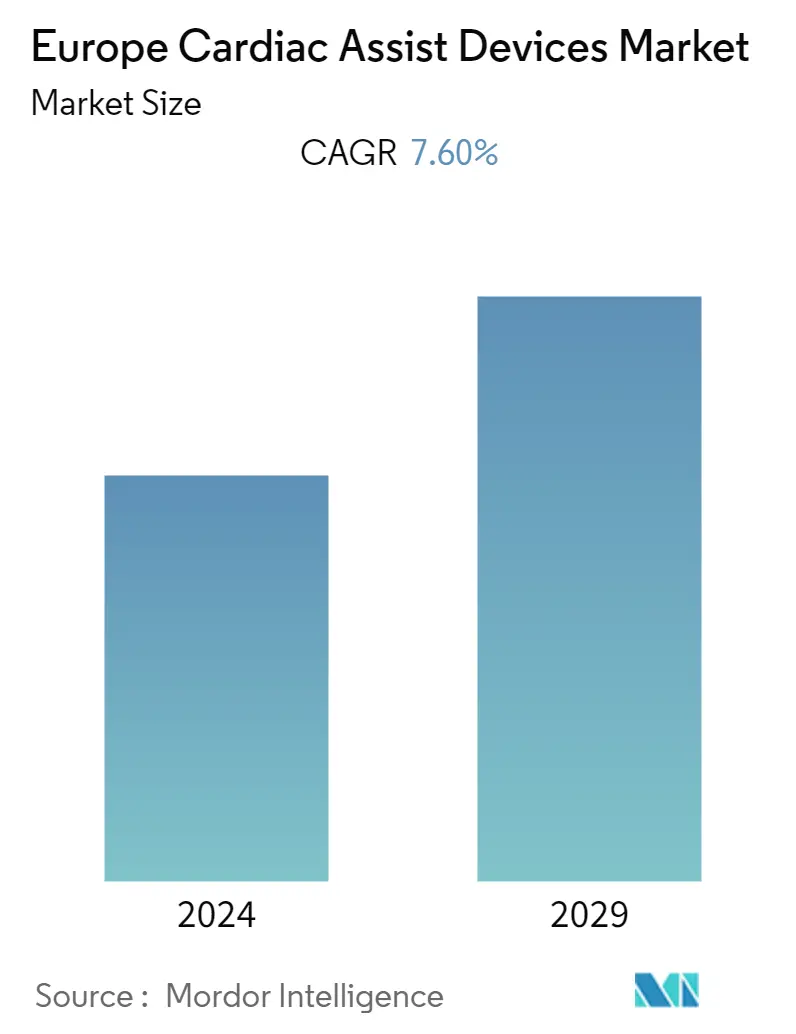
| Study Period | 2019 - 2029 |
| Base Year For Estimation | 2023 |
| Forecast Data Period | 2024 - 2029 |
| Historical Data Period | 2019 - 2022 |
| CAGR | 7.60 % |
Major Players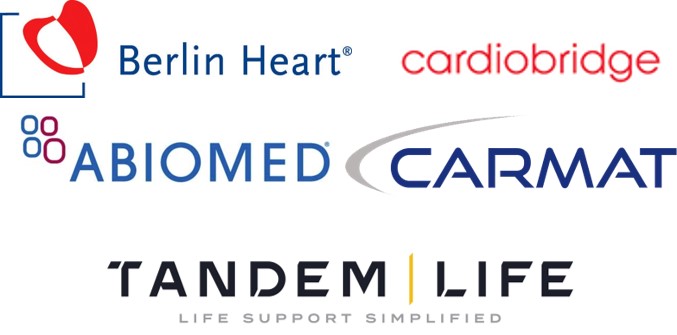
*Disclaimer: Major Players sorted in no particular order |
Europe Cardiac Assist Devices Market Analysis
The Europe cardiac assist devices market is expected to register a CAGR of 7.6% during the forecast period of the study.
- The COVID-19 pandemic affected the studied market significantly. Since the pandemic's beginning, healthcare systems in European countries have resulted in the interruption of usual care in many healthcare facilities, exposing vulnerable patients with cardiovascular diseases to significant risks. For instance, according to the article published by PubMed in July 2021, a study was conducted in Sweden, which showed that COVID-19 was found to be a risk factor for acute myocardial infarction and ischemic stroke.
- The findings of the study also suggested that the clinical profile of COVID-19 includes acute myocardial infarction and ischemic stroke. Thus, there was an increased risk of various cardiovascular diseases (CVD) among the target population in Europe. However, as COVID-19 was considered a probable risk factor for acute cardiovascular complications, the demand for cardiovascular devices increased during the pandemic in the region. Thus, the pandemic had a significant impact on the studied market, but as the pandemic has subsided currently, cardiac care has gone back to normal, so the studied market is expected to have stable growth during the forecast period of the study.
- The increasing prevalence and incidence of heart diseases, such as heart failure, among others, are one of the major factors driving the market growth, as these diseases require the usage of cardiac assist devices for the treatment procedure. For instance, according to an article published by the European Heart Journal in September 2022, heart failure (HF) is considered one of the leading causes of hospitalizations and readmissions in Europe, and its prevalence and costs continue to rise, which makes it a significant population health issue.
- Furthermore, according to the research article published by ScienceDirect in January 2022, heart failure is said to have a high prevalence in Spain, with a pooled prevalence rate of around 2%. Thus, such a burden and persistent risk of CVD among the target population in Europe is expected to increase the demand for cardiac assist devices, thereby driving the market growth.
- The increasing mergers and acquisitions of products and services and product innovations fuel market growth, as this will lead to access to more technologically advanced products in the region. For instance, in June 2022, Coala-Life Group AB agreed to acquire 100% of the shares in Vitrics Management Group Inc for a purchase price of USD 4.5 million on a cash and debt-free basis. Vitrics' platform and customer base will be able to be scaled up through Coala's national sales force, enable faster organic growth, and effectively get the Coala Heart Monitor out to even more patients in need, which is expected to increase the usage of cardiac assist devices in the region.
- Therefore, the aforesaid factors are expected to contribute to the growth of the studied market. However, the high cost and maintenance issues and risks associated with device implantation might hamper the market's growth over the analysis period.
Europe Cardiac Assist Devices Market Trends
The Total Artificial Heart Segment is Expected to Hold Significant Market Share Over the Forecast Period
- The total artificial heart (TAH) is a form of mechanical circulatory support in which the patient's native ventricles and valves are explanted and replaced by a pneumatically powered artificial heart. TAH is generally used in end-stage biventricular heart failure as a bridge to heart transplantation. TAH is often preferred over other cardiac assist devices as a last resort for the treatment of heart failure in patients.
- Thus, it is expected to hold a major share of the studied market. Other factors, such as the increasing rate of heart failures coupled with the rising geriatric population and the introduction of technologically advanced products, are also expected to enhance segment growth during the forecast period of the study.
- For instance, according to an article published by the European Heart Journal in December 2022, heart failure (HF) is one of the major clinical and public health challenges in France, and the rates of HF hospitalizations have remained steady in France. The source also stated that its incidence is expected to increase with age, and the median age of HF patients in European countries exceeds 70 years. Thus HF is primarily considered to be a disease affecting the elderly. Thus, the high prevalence of heart failure coupled with the rising geriatric population is expected to boost segment growth.
- Moreover, according to the data published by Eurostat in February 2023, more than one-fifth or 21.1 % of the European population was aged 65 and over in 2022, and the median age of the European population was increasing and was 44.4 years on January 2022, which meant that half of the European population was older than 44.4 years. Therefore, the aforementioned factors, such as the rising heart failures coupled with the growing geriatric population, are expected to enhance segment growth.
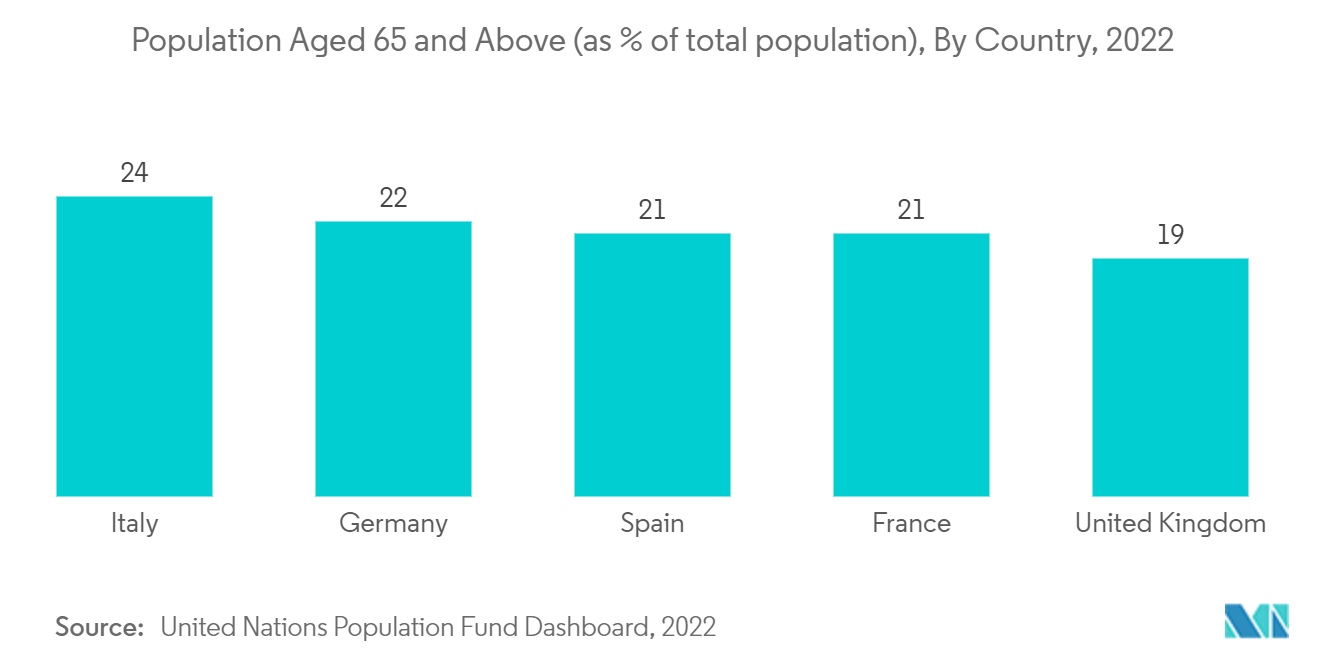
The United Kingdom is Expected to Hold Significant Market Share Over the Forecast Period
- The United Kingdom is expected to hold a major share of the market due to the rising prevalence of heart failure in the country, the availability of advanced products, and the rising geriatric population.
- The rising prevalence of heart failure is the major factor driving the segment's growth. For instance, according to the data published by the British Heart Foundation in 2022, an estimated 207,851 inpatient episodes of heart failure took place in the United Kingdom in 2021. Thus, the high prevalence of heart failure in the country is expected to boost segment growth.
- Moreover, according to an article published by PubMed in August 2022, a study was conducted in the United Kingdom, which showed that the overall pooled incidence of heart failure was 98.5 per 10,000 people every year over a median of 6.1 years of follow-up. Thus, the high incidence of heart failure in the country is also expected to boost the usage of cardiac assist devices during the forecast period of the study.
- Furthermore, according to the data published by United Nations (UN) Populations Fund Dashboard in 2022, an estimated 19% of the population in the United Kingdom were aged 65 years or older in 2022. Thus, the growing geriatric population in the country is also expected to boost segment growth, as heart failure is more common in older people. Hence, the aforementioned factors, such as the rising prevalence of heart failure coupled with the growing geriatric population, are expected to enhance the market growth in the country.
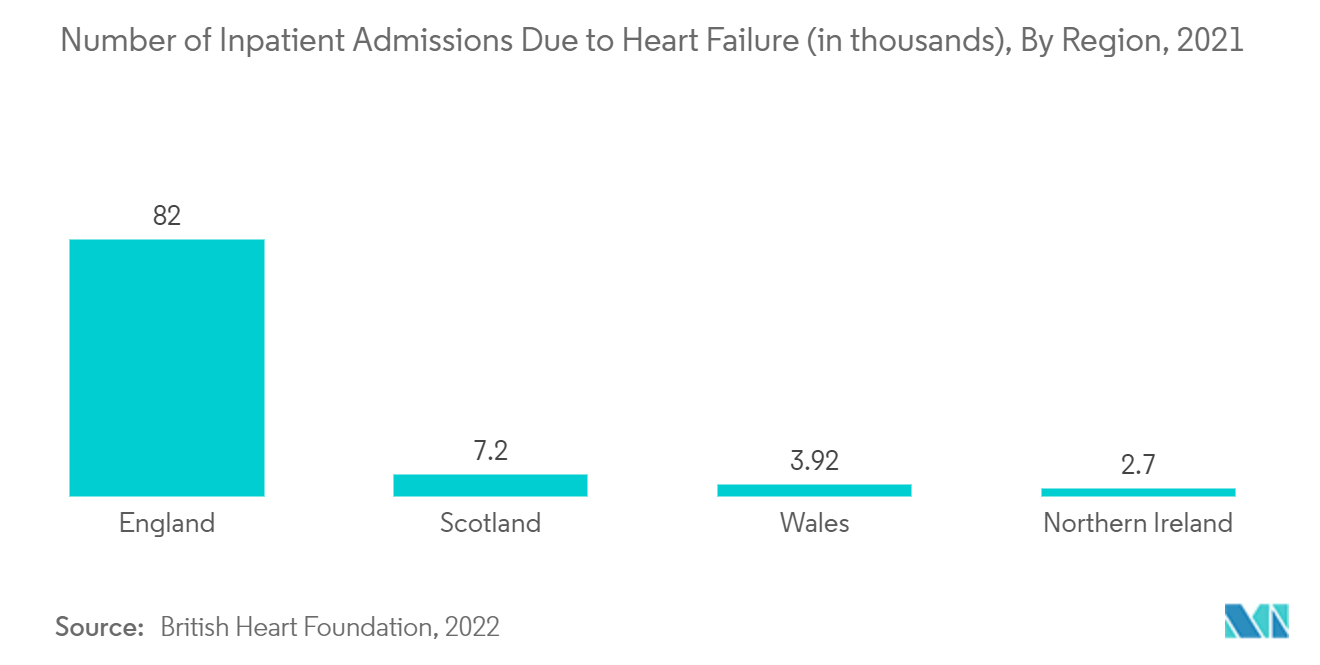
Europe Cardiac Assist Devices Industry Overview
The European cardiac assist devices market is competitive and consists of a number of major players. Companies like Abiomed, Berlin Heart, Cardiobridge GmbH, Carmat, Jarvik Heart Inc., Xenios AG, MiTiHeart Corporation, and SynCardia Systems LLC, among others, hold a substantial market share in the European cardiac assist devices market.
Europe Cardiac Assist Devices Market Leaders
-
Abiomed
-
Cardiobridge GmbH
-
Carmat
-
Berlin Heart
-
LivaNova, Inc.
*Disclaimer: Major Players sorted in no particular order
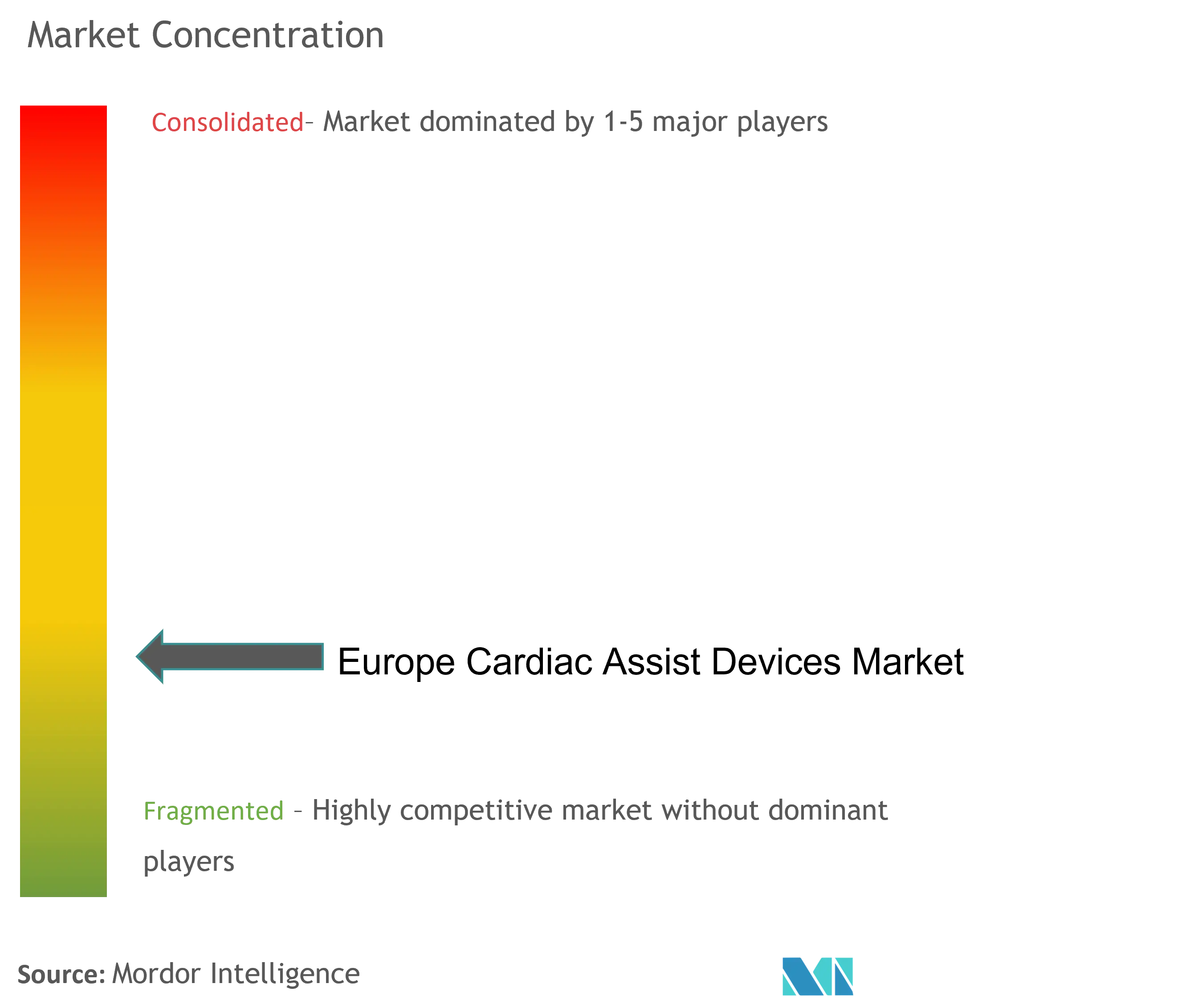
Europe Cardiac Assist Devices Market News
- February 2023: ArtOfHeart, partly funded by the European Innovation Council (EIC), invested EUR 38 million (USD 43.04 million) to conduct clinical and pre-clinical testing of an artificial heart developed by Swedish company Scandinavian Real Heart AB.
- January 2023: Realheart and KTH partnered up to optimize artificial heart function in Sweden's first patient simulator.
Europe Cardiac Assist Devices Market Report - Table of Contents
1. INTRODUCTION
- 1.1 Study Assumptions and Market Definition
- 1.2 Scope of the Study
2. RESEARCH METHODOLOGY
3. EXECUTIVE SUMMARY
4. MARKET DYNAMICS
- 4.1 Market Overview
-
4.2 Market Drivers
- 4.2.1 Increasing Prevalence of Heart Diseases
- 4.2.2 Advancements in Technology of Cardiac Assist Devices
-
4.3 Market Restraints
- 4.3.1 High Cost and Maintenance Issues
- 4.3.2 Risk Associated with Device Implantation
-
4.4 Porter's Five Forces Analysis
- 4.4.1 Threat of New Entrants
- 4.4.2 Bargaining Power of Buyers/Consumers
- 4.4.3 Bargaining Power of Suppliers
- 4.4.4 Threat of Substitute Products
- 4.4.5 Intensity of Competitive Rivalry
5. MARKET SEGMENTATION (Market Size by Value - USD million)
-
5.1 By Product
- 5.1.1 Intra-aortic Balloon Pumps
- 5.1.2 Total Artificial Heart
- 5.1.3 Ventricular Assist Devices
- 5.1.3.1 Left Ventricular Assist Devices
- 5.1.3.2 Right Ventricular Assist Devices
-
5.2 Geography
- 5.2.1 Germany
- 5.2.2 United Kingdom
- 5.2.3 France
- 5.2.4 Italy
- 5.2.5 Spain
- 5.2.6 Rest of Europe
6. COMPETITIVE LANDSCAPE
-
6.1 Company Profiles
- 6.1.1 Abiomed
- 6.1.2 Berlin Heart
- 6.1.3 LivaNova, Inc.
- 6.1.4 Cardiobridge GmbH
- 6.1.5 Carmat
- 6.1.6 Medtronic
- 6.1.7 Jarvik Heart Inc.
- 6.1.8 Xenios AG (Fresenius Medical Care)
- 6.1.9 MiTiHeart Corporation (Mohawk Innovative Technology, Inc.)
- 6.1.10 SynCardia Systems LLC
- 6.1.11 CorWave SA
- 6.1.12 Evaheart, Inc.
- *List Not Exhaustive
7. MARKET OPPORTUNITIES AND FUTURE TRENDS
** Subject To AvailablityEurope Cardiac Assist Devices Industry Segmentation
As per the scope of the report, the assist devices are defined as a type of mechanical pump that works along with the heart to improve the pumping efficiency and maintain optimum blood flow throughout the body. Cardiac-assist devices are used to treat end-stage heart failure and are determined by the needs of the individual.
The Europe cardiac assist devices market is segmented by product (intra-aortic balloon pump, total artificial heart, and ventricular assist device (left ventricular assist devices and right ventricular assist devices), and geography (Germany, United Kingdom, France, Italy, Spain, and the Rest of Europe).
The report offers the value (in USD million) for the above segments.
| By Product | Intra-aortic Balloon Pumps | |
| Total Artificial Heart | ||
| Ventricular Assist Devices | Left Ventricular Assist Devices | |
| Right Ventricular Assist Devices | ||
| Geography | Germany | |
| United Kingdom | ||
| France | ||
| Italy | ||
| Spain | ||
| Rest of Europe |
Europe Cardiac Assist Devices Market Research FAQs
What is the current Europe Cardiac Assist Devices Market size?
The Europe Cardiac Assist Devices Market is projected to register a CAGR of 7.60% during the forecast period (2024-2029)
Who are the key players in Europe Cardiac Assist Devices Market?
Abiomed, Cardiobridge GmbH, Carmat, Berlin Heart and LivaNova, Inc. are the major companies operating in the Europe Cardiac Assist Devices Market.
What years does this Europe Cardiac Assist Devices Market cover?
The report covers the Europe Cardiac Assist Devices Market historical market size for years: 2019, 2020, 2021, 2022 and 2023. The report also forecasts the Europe Cardiac Assist Devices Market size for years: 2024, 2025, 2026, 2027, 2028 and 2029.
Europe Cardiac Assist Devices Industry Report
Statistics for the 2024 Europe Cardiac Assist Devices market share, size and revenue growth rate, created by Mordor Intelligence™ Industry Reports. Europe Cardiac Assist Devices analysis includes a market forecast outlook 2029 and historical overview. Get a sample of this industry analysis as a free report PDF download.



